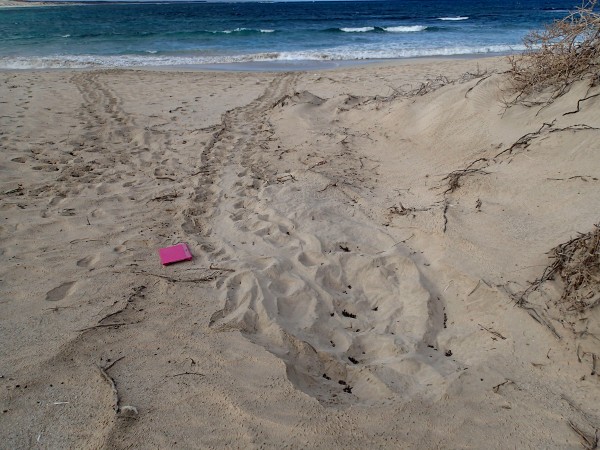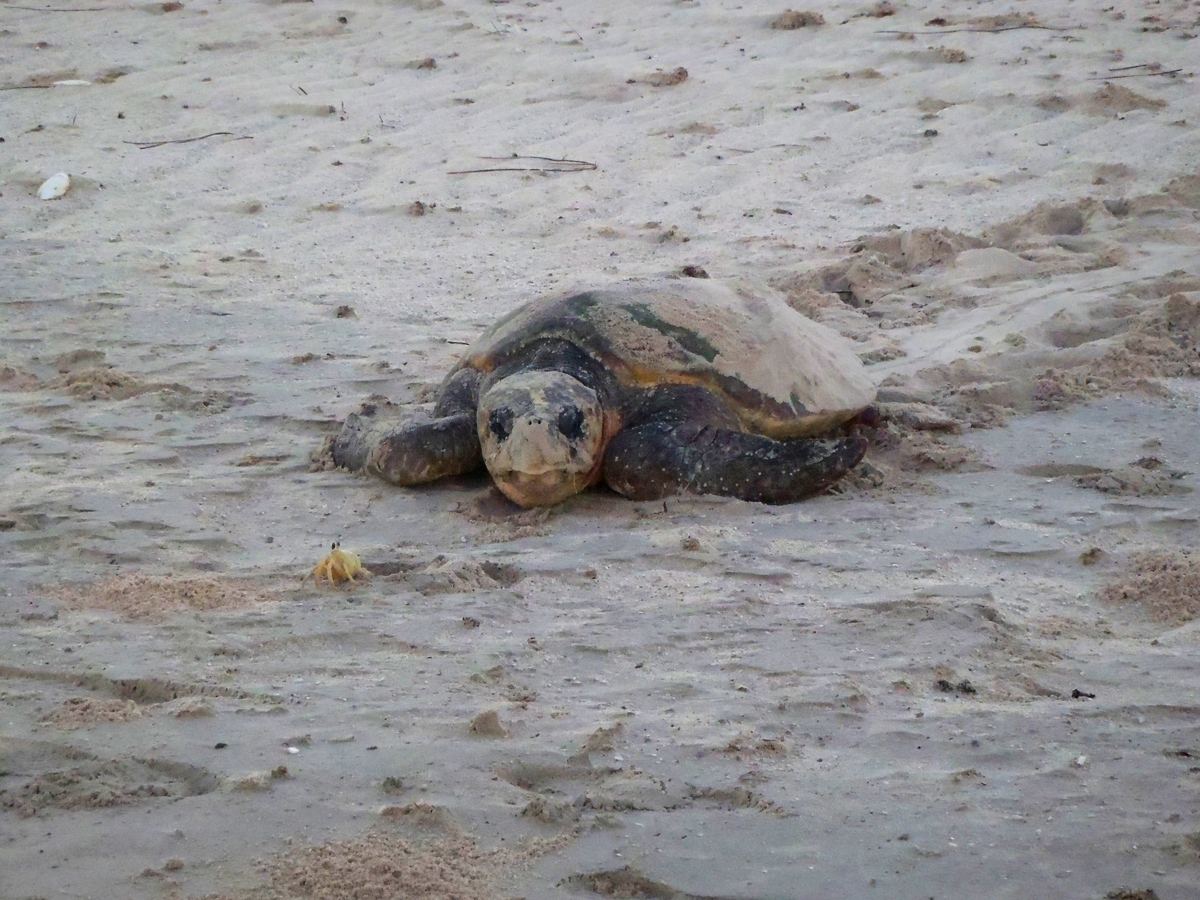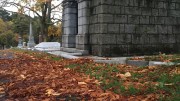January 5, 2015
We’re officially midway through sea turtle nesting season and are currently recording up to 15 activities per day here at Gnaraloo Bay Rookery, a sea turtle conservation program in Western Australia. This is a program I have been working with since October 2014. Now is a great opportunity to shed light on sea turtle nesting behaviour and monitoring methods.
Sea turtles nest at night and they do this for two reasons: first, the cover of darkness, which helps conceal them from predators; second, because it is cooler. Sea turtles are cold-blooded and nesting can take hours. Prolonged exposure to the sun can be very hazardous.
Programs which have tagging permits will mainly operate at night, but Gnaraloo is still a program in its infancy and does not yet have the required licensing to tag sea turtles. Currently, with the small staff size, it is most effective to survey the rookery at sunrise as opposed to having researchers walk the beach from dusk until dawn each night.
Although the program primarily monitors sea turtle nesting activities in the morning, we do conduct night surveys for a select period of time to decrease and measure the possible margin of error made by day surveyors in the Gnaraloo Bay Rookery.
The number of days that night surveys are conducted is initially unknown, since it is based on the number of observed emerging turtles and observed nesting activities. The number of turtles that must be witnessed is statistically determined based on the previous season’s data. This season we were required to witness 51 nesting activities and 10 species identifications, with the goal of reaching 80 per cent accuracy and 90 per cent accuracy, respectively.
Nesting activities are broken down into four categories: nests, unsuccessful nesting attempts, U tracks, and unknown activities. Sometimes it can be very difficult to distinguish between these activities, particularly nests and unsuccessful nesting attempts, so we look for specific features formed throughout each step of the turtles’ nesting rituals.
The turtle emerges from the sea, and makes her makes her way up the beach to a suitable nesting site, ideally beyond the intertidal zone. There, she’ll begin to body pit. This action of “body pitting” creates misting over the emergence track and a primary escarpment.
Once satisfied with her body pit, she digs an egg chamber with her rear flippers that is large enough to store her clutch (100-130 ping pong ball-sized eggs).
While she’s depositing her eggs, she goes into a trance-like state. It is at this point when any tagging, measuring, or sampling of the turtle would occur, but Gnaraloo currently does not handle the turtles in any way, striving to leave them as undisturbed as possible.
When she is finished depositing her eggs, she uses her back flippers to fill in the chamber and cover the clutch, which creates a mound.
Finally, she camouflages her nest by flinging sand over it with her flippers, forming a secondary body pit and disguising the nest with fluffy, aerated sand before she returns to the sea.

Photo Credit: Melissa Tan
The main features we look for to confirm if a recorded activity is a nest or not is misting over the emergence track, an escarpment from the primary and secondary body pit, mounding, a secondary body pit, fluffy aerated sand, and uprooted vegetation.
Not all nests are by the book – sometimes the features we need to identify can be quite obscure, making interpretation difficult. This is why verification through night survey is a great way to establish how adept the research team is at deciphering the nesting activities and provide confidence to the data collected.
Since witnessing nesting turtles largely depends on unpredictable spatial and temporal fluctuations, it is impossible to predetermine when the nesting activity determination and species identification quota for night survey will be reached.
Luckily, this season we wrapped up on Dec. 23 (totalling 23 nights). Spending the holidays in the Southern Hemisphere has been an interesting experience. I wouldn’t go as far as to say a “culture shock,” but I definitely missed some coveted Northern comforts.
We did have a turkey, but oddly enough it had no legs, which made a traditional stuffing impossible. This was of no concern to my Aussie companions as the hot days of midsummer demand a lighter fare. The ham was served cold and our side dishes were salads – quite the opposite of the comfort foods I’m accustomed to.
I was also surprised to find out that everyone here goes mad for stone fruit at this time of year and that mangoes are a must-have Christmas treat. Oh, and let’s not forget “shrimp on the barbie!” Every Australian you talk to will claim that this statement is a falsehood – because they call them prawns.
Over the few days spanning the holidays, the temperature rose to 40 C and the wind which had become a dependable constant eerily ceased. Gnaraloo is described as a place “where the desert meets the sea,” and although the landscape reflects the desert, the wind masks the heat.
Western Australia is particularly windy due to a sea breeze which blows southwesterly from the Indian Ocean and is smartly called the “Fremantle Doctor” by locals. “Fremantle” is a suburb of Perth in the direction from which it blows, and “Doctor” describes the relief it brings from the heat.
The Fremantle Doctor is generated by differentials between land and ocean temperatures; cooler air from above the sea replaces the rising, warmer air over the land. The wind peaks in December and January and then weakens in February. So our few days of agonizing heat were a little out of the norm, but easily tolerated when you work on a beach.
The sea turtle nest numbers continue to climb, and are right on track for our goal of 300 nests. We have 152 nests recorded in Gnaraloo Bay Rookery at the halfway mark of the season. So far, we’ve only identified loggerhead (Caretta caretta) activities in the rookery, but we’re still hopeful to observe green (Chelonia mydas) and hawksbill (Eretmochelys imbricata) activities before the season’s end.




